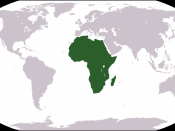In the 18th century, Europe's coffee demands were met by plantations in the Caribbean. Plantations were large farms run usually by one rich family on which worked many slaves that cultivated the land and provided all of the labor. As the native population of the Americas were greatly reduced by disease, Europeans imported slaves from Africa to work on the plantations. Taken against their will by slave ships across the Atlantic, they were bought and sold throughout the New World. To make a profit on cash crops such as coffee, landowners needed to expand their fields as much as possible. This required a vast amount of man-power that led to the enormous increase in the importation of slaves from Africa.
Most of the slaves on Caribbean plantations worked in the fields cultivating the plants and harvesting. The majority of the field laborers were women, and even pregnant women and nursing women were given no labor reprieve.
Sex did play a role in the treatment of slaves. Some men were given privileged positions such as heads of field gangs, tradesmen, and watchmen while women were not. While there are instances of skilled slaves receiving rewards for their efforts, their motivation to work was fueled by the threat of force.
North American unfree labor systems were modeled after the plantations in the Caribbean, so there are many similarities between the two. In both instances, slaves were imported from Africa against their will to work on plantations run by rich, white families. The importation of slaves to North America, though, was much less than to the West Indies. They did not require as large a labor force as did the large coffee and sugar plantations in the Caribbean. Also, the North American climate did not cause as many deaths among slaves...



Good Job
This essay is good. I enjoyed reading it.
2 out of 2 people found this comment useful.